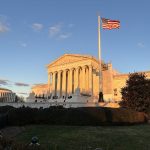Supreme Court expands time frame to sue federal agencies

Share
The Supreme Court on Monday ruled that a North Dakota truck stop can bring a challenge to a regulation issued 13 years ago by the Federal Reserve Board. In a 6-3 vote divided along ideological lines, the justices significantly expanded plaintiffs’ ability to sue federal regulators, ruling that the statute of limitations to challenge an action by a federal agency begins to run when the plaintiff is injured by the action, even if – as happened in this case – that happens long after the agency’s action occurs.
Writing for the majority, Justice Amy Coney Barrett characterized the case as “straightforward.” But Justice Ketanji Brown Jackson, writing for the dissenting liberal bloc, warned that the decision could have “staggering” implications, particularly in light of the court’s decision on June 28 eliminating the doctrine of deference to an agency’s reasonable interpretation of the laws that it administers.
In 2021, when Corner Post, a truck stop and convenience store in Watford City, N.D., joined a lawsuit challenging a 2011 regulation issued by the Federal Reserve Board governing the fees that merchants must pay whenever their customers use a debit card. A federal district court dismissed the case. It reasoned that the six-year statute of limitations imposed by the Administrative Procedure Act, the federal law governing agency actions and the legal challenges to them, applied, even though Corner Post had not opened its doors until 2018.
A federal appeals court upheld the district court’s dismissal of the case, but the Supreme Court on Monday reversed. Barrett explained that the statute of limitations “begins to run only when the plaintiff has a complete and present cause of action.” To bring a challenge under the APA, she continued, a plaintiff must show that it was injured by the agency’s actions. This means, she reasoned, that Corner Post did not have a “complete and present” cause of action until it was injured by the Fed’s 2011 rule – that is, when it opened for business in 2018. Therefore, the truck stop’s lawsuit is not barred by the six-year statute of limitations.
Barrett pushed back against the Fed’s suggestion that the court’s decision would deprive both agencies and the entities that they regulate of much-needed finality, by allowing challenges to regulations more than six years after the regulations are issued. The prospect of “administrative inconvenience,” Barrett wrote, does not “justify departing from the statute’s clear text.” Moreover, she added, Congress could have used language to make clear that the statute of limitations begins to run when the regulation is issued or the agency action takes place, but it did not.
Barrett also characterized the Fed’s concerns as “overstated,” observing that entities subject to agency regulation can always challenge the regulation as it applies to them. And in any event, she continued, “the opportunity to challenge agency action does not mean that new plaintiffs will always win or that courts and agencies will win or that courts and agencies will need to expend significant resources to address each new suit.” Monday’s decision, she observed, also “respects our deep-rooted historic tradition that everyone should have his own day in court.”
Justice Brett Kavanaugh joined Barrett’s opinion but also wrote separately to weigh in on a question that the Biden administration has raised in some recent cases: What power do federal courts have when it comes to agency actions that they deem improper? Kavanaugh rejected the government’s contention that the courts can only bar agencies from enforcing the improper rule against a particular challenger. Instead, he maintained, the APA allows courts to invalidate the rule more broadly. A contrary rule, he suggested, “would revolutionize long-settled administrative law — shutting the door on entire classes of everyday administrative law cases.”
In her 24-page dissent, Jackson complained that the majority’s “baseless conclusion means that there is effectively no longer any limitations period for lawsuits that challenge agency regulations on their face.”
Pointing to a ruling by a federal appeals court that turned aside a challenge to the Food and Drug Administration’s approval of mifepristone, one of two drugs used in medication abortions, on the ground that it came too late, Jackson emphasized that “even the most well-settled agency regulations can be placed on the chopping block” after Monday’s ruling. “Any established government regulation about any issue — say, workplace safety, toxic waste, or consumer protection — can now be attacked by any new regulated entity within six years of the entity’s formation,” Jackson wrote.
Such a result, Jackson predicted, will be “profoundly destabilizing.” But that is particularly true, she continued, in the wake of the court’s recent decision in Loper-Bright Enterprises v. Raimondo. The court in that case overturned its 1984 decision in Chevron v. Natural Resources Defense Council, in which it held that when a statute is ambiguous, courts should generally defer to an agency’s reasonable interpretation of that law.
Taken together, Jackson cautioned, the two decisions could create a “tsunami of lawsuits” with “the potential to devastate the functioning of the Federal Government.” Moreover, she added, “that result simply cannot be what Congress intended, and she encouraged Congress to step in and amend the APA to make clear that challenges to an agency regulation or action must be filed within six years of the action.
This article was originally published at Howe on the Court.
The post Supreme Court expands time frame to sue federal agencies appeared first on SCOTUSblog.
